Creating a content calendar is essential for effective communication with your audience, particularly in South Africa, where understanding local interests and cultural nuances is key. A well-structured calendar not only improves organization and consistency in publishing but also fosters collaboration among teams, ensuring a steady flow of relevant content. By establishing a clear plan for scheduling, you can enhance audience engagement and loyalty through predictable and timely updates.
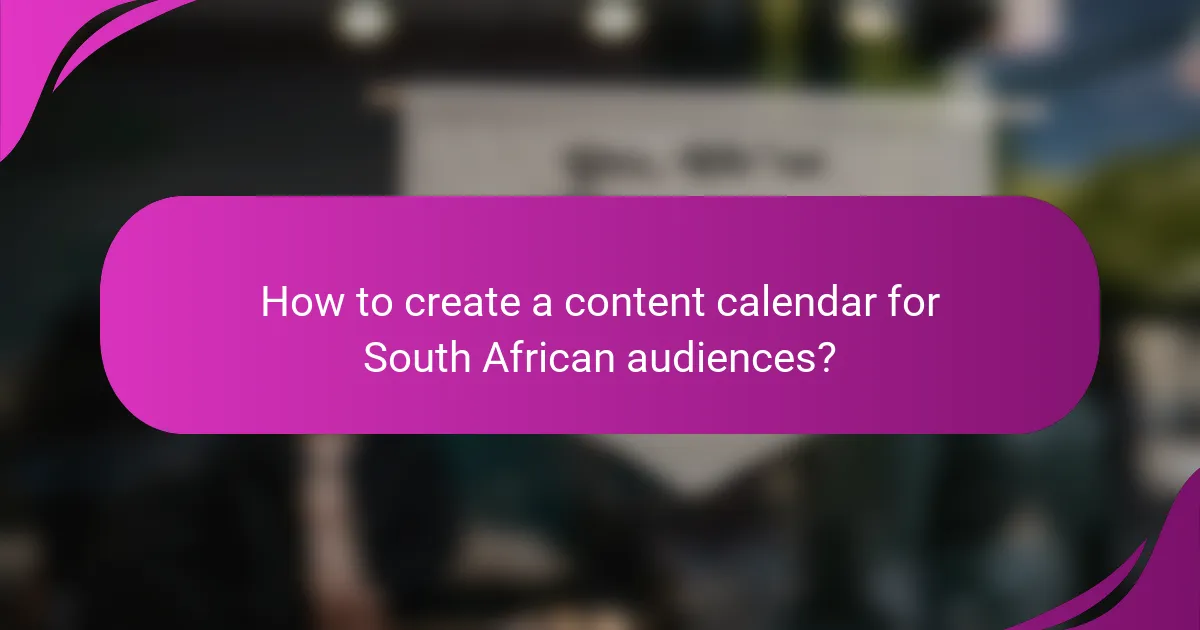
How to create a content calendar for South African audiences?
Creating a content calendar for South African audiences involves understanding local interests, cultural nuances, and effective scheduling practices. This ensures that your content resonates with the target demographic while maintaining consistency and relevance.
Identify key themes and topics
Start by researching what topics are trending in South Africa and what resonates with your audience. Consider themes such as local sports events, cultural festivals, and social issues that are significant to South Africans.
Utilize tools like Google Trends and social media analytics to identify popular subjects. This data will help you create content that aligns with the interests and needs of your audience.
Choose the right tools for scheduling
Selecting the appropriate tools for scheduling is crucial for maintaining your content calendar. Platforms like Trello, Asana, or Google Calendar can help you organize and visualize your content plan effectively.
Consider tools that allow for collaboration if you have a team. Ensure that the tool you choose can accommodate reminders and notifications to keep everyone on track with deadlines.
Set deadlines and milestones
Establish clear deadlines for each piece of content to ensure timely delivery. Break down larger projects into manageable milestones to track progress and maintain motivation.
For example, if you plan to launch a campaign, set deadlines for brainstorming, drafting, editing, and publishing. This structured approach helps avoid last-minute rushes and enhances content quality.
Incorporate local events and holidays
Integrating local events and holidays into your content calendar is essential for relevance. South Africa has numerous public holidays and cultural celebrations, such as Heritage Day and Freedom Day, which can be leveraged for themed content.
Align your content with these dates to engage your audience effectively. For instance, create promotional content around Black Friday or local festivals to capitalize on heightened consumer interest during these times.
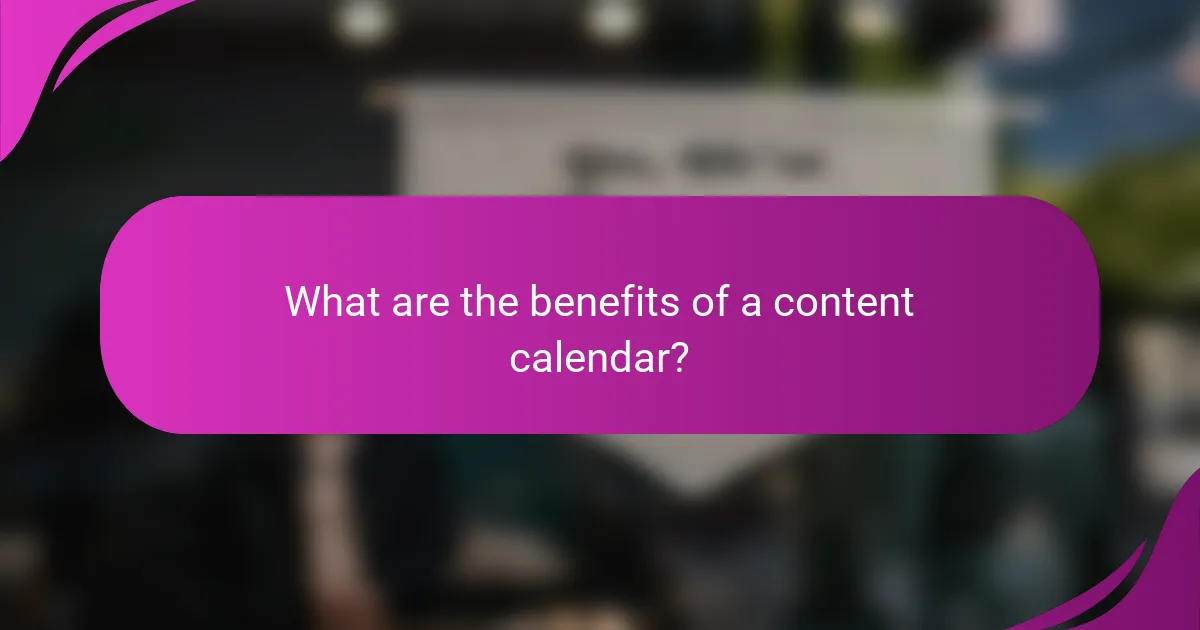
What are the benefits of a content calendar?
A content calendar offers several advantages, including improved organization, consistent publishing, and enhanced collaboration. By planning content in advance, teams can ensure a steady flow of material that resonates with their audience.
Improved consistency in publishing
Consistency in publishing is crucial for maintaining audience interest and trust. A content calendar helps schedule posts at regular intervals, whether daily, weekly, or monthly, ensuring that content is delivered reliably.
To achieve this, set clear deadlines for each piece of content and adhere to them. For example, if you aim for three blog posts per week, mark specific days for writing, editing, and publishing to keep the workflow on track.
Enhanced collaboration among teams
A content calendar fosters better collaboration among team members by providing a shared timeline and clear responsibilities. Everyone involved can see what content is planned, who is responsible for each piece, and when it is due.
Utilize tools like Google Sheets or project management software to create a visual calendar that everyone can access. This transparency helps prevent overlap and ensures that all voices are heard in the content creation process.
Better audience engagement
Engaging your audience effectively requires strategic planning, which a content calendar facilitates. By analyzing audience preferences and scheduling relevant content accordingly, you can enhance interaction and response rates.
Consider seasonal trends, holidays, or events that resonate with your audience. For instance, if your target demographic is interested in fitness, plan content around New Year resolutions or summer fitness tips to maximize engagement.
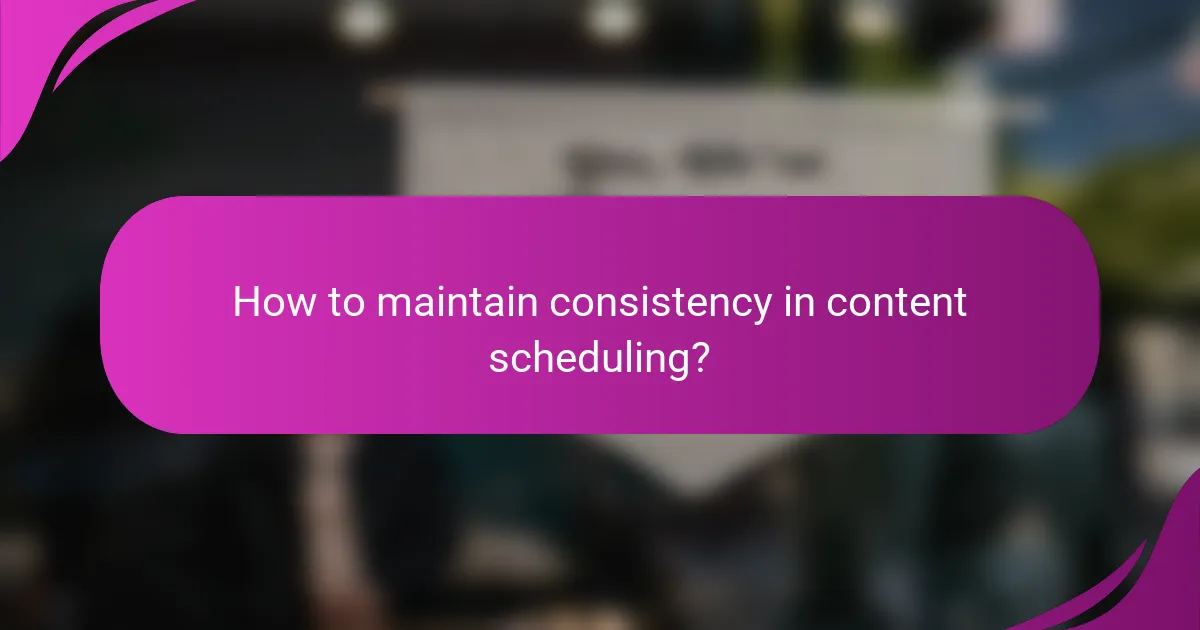
How to maintain consistency in content scheduling?
To maintain consistency in content scheduling, establish a clear plan that outlines when and how often you will publish. This ensures that your audience knows what to expect, which can enhance engagement and loyalty.
Establish a regular publishing frequency
Setting a regular publishing frequency is crucial for consistency. Aim for a schedule that is manageable, whether it’s weekly, bi-weekly, or monthly. Regularity helps build anticipation among your audience, making them more likely to return for new content.
Consider your resources and the type of content you produce. For instance, a blog might benefit from weekly posts, while a podcast could be effective on a bi-weekly basis. Adjust your frequency based on your capacity to deliver quality content consistently.
Utilize automation tools
Automation tools can significantly streamline your content scheduling process. Platforms like Buffer or Hootsuite allow you to schedule posts in advance, ensuring that your content goes live at optimal times without manual intervention.
Using automation not only saves time but also helps maintain your publishing frequency. However, be cautious to monitor automated posts for relevance and engagement, as automated content can sometimes miss the mark if not regularly reviewed.
Monitor and adjust based on performance
Regularly monitoring your content’s performance is essential for maintaining consistency. Use analytics tools to track engagement metrics such as views, shares, and comments. This data will help you understand what resonates with your audience.
Be prepared to adjust your content schedule based on these insights. If certain topics or formats perform better, consider increasing their frequency. Conversely, if something isn’t working, it may be time to revise your approach or frequency to better align with audience preferences.
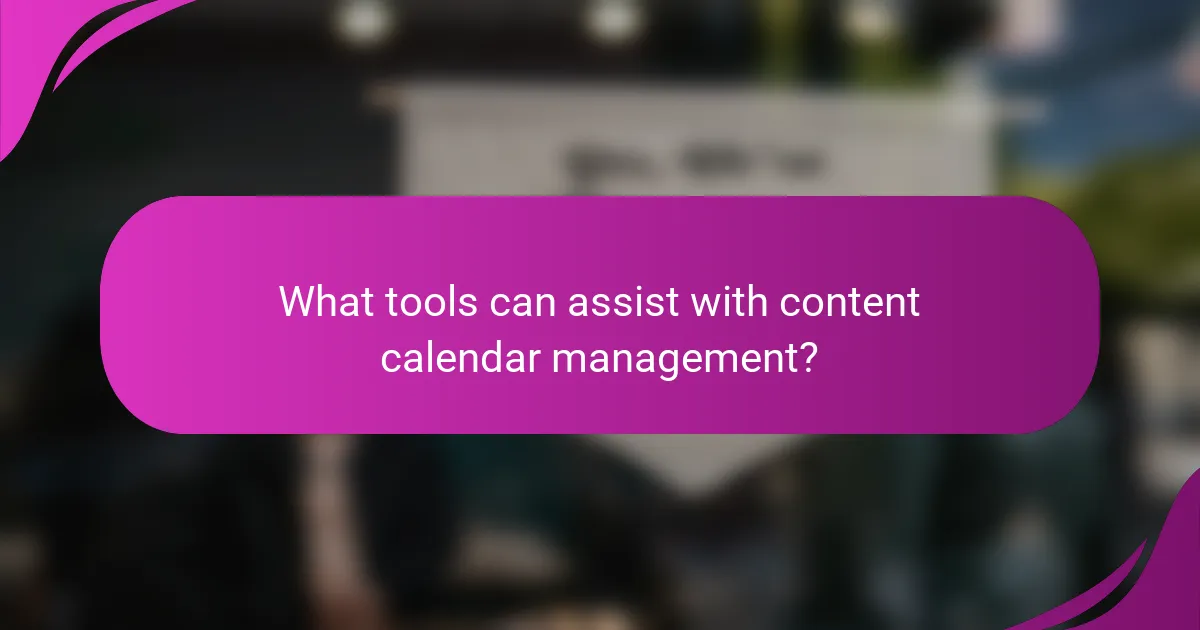
What tools can assist with content calendar management?
Several tools can streamline content calendar management by enhancing organization, scheduling, and collaboration. Popular options include Trello, Google Calendar, and CoSchedule, each offering unique features tailored to different aspects of content planning.
Trello for project management
Trello is a visual project management tool that uses boards, lists, and cards to organize tasks. It allows teams to create a content calendar by setting up boards for different projects and adding cards for individual content pieces, which can be moved through various stages of completion.
To maximize Trello’s effectiveness, consider using labels for categorizing content types and due dates to keep track of deadlines. Integrating checklists within cards can help ensure all necessary steps are completed before publication.
Google Calendar for scheduling
Google Calendar is an accessible scheduling tool that helps manage content publication dates and deadlines. Users can create events for each piece of content, set reminders, and share calendars with team members for better visibility.
Utilizing color coding for different content types or campaigns can enhance clarity. Regularly reviewing the calendar helps maintain consistency and allows for adjustments based on performance or changing priorities.
CoSchedule for marketing integration
CoSchedule is designed specifically for marketers, offering a comprehensive solution for content planning and promotion. It integrates with various platforms, allowing users to schedule social media posts alongside blog content, ensuring a cohesive marketing strategy.
To get the most out of CoSchedule, leverage its analytics features to track engagement and adjust future content based on performance metrics. This tool is particularly useful for teams looking to align their content marketing efforts with broader business goals.
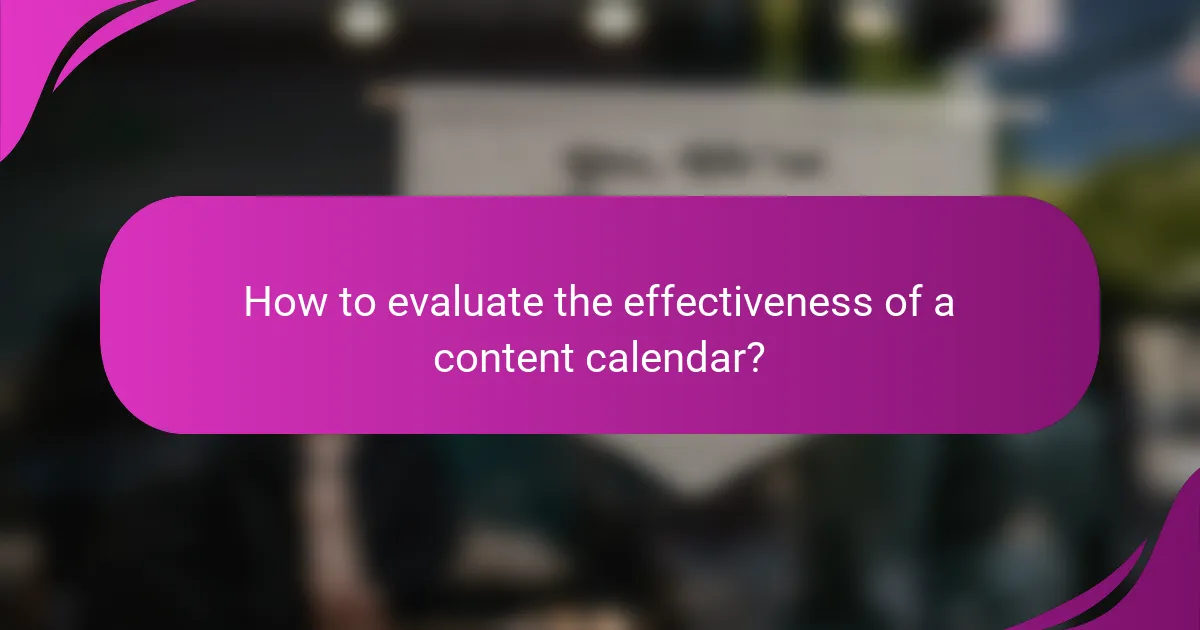
How to evaluate the effectiveness of a content calendar?
To evaluate the effectiveness of a content calendar, focus on audience engagement and content performance relative to your goals. This assessment helps identify what resonates with your audience and guides future content strategies.
Analyze audience engagement metrics
Start by examining key audience engagement metrics such as likes, shares, comments, and time spent on page. These indicators reveal how well your content captures attention and encourages interaction. Aim for engagement rates that align with industry benchmarks, typically ranging from 1% to 5% for social media posts.
Utilize tools like Google Analytics or social media insights to track these metrics over time. Look for trends that indicate which types of content generate the most engagement, allowing you to adjust your calendar accordingly. For instance, if video content consistently outperforms blog posts, consider increasing your video output.
Review content performance against goals
Assess how your content aligns with your predefined goals, such as increasing brand awareness, generating leads, or driving website traffic. Use metrics like conversion rates, click-through rates, and overall traffic growth to measure success. A good practice is to set specific, measurable goals and review them quarterly.
Compare the performance of different content types against these goals. If a particular campaign resulted in a significant uptick in leads, analyze what worked and replicate those strategies in future content. Avoid the pitfall of sticking to a calendar without assessing its impact; adapt your approach based on performance data to maximize effectiveness.
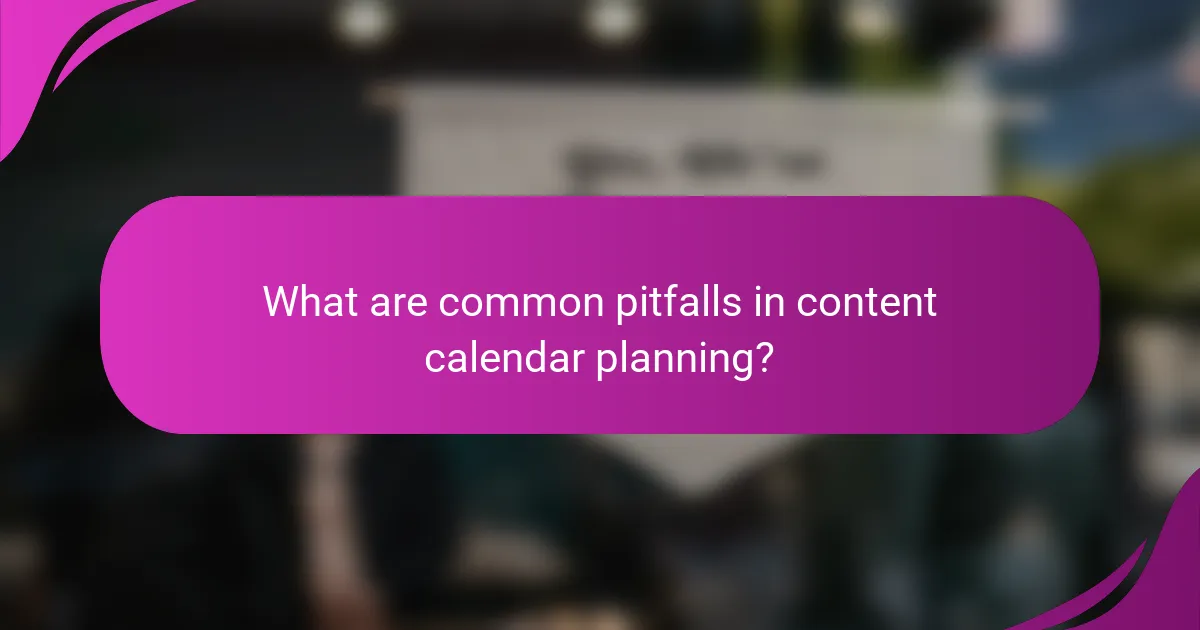
What are common pitfalls in content calendar planning?
Common pitfalls in content calendar planning include failing to consider audience preferences and neglecting seasonal trends. These oversights can lead to content that does not resonate with your target audience or misses key opportunities for engagement.
Neglecting audience preferences
Understanding your audience is crucial for effective content calendar planning. If you overlook their preferences, you risk creating content that does not engage or attract them. Conduct surveys or analyze past performance to identify topics and formats that resonate.
Consider segmenting your audience based on demographics or interests. Tailoring content to specific groups can enhance engagement and improve overall effectiveness. For instance, younger audiences may prefer video content, while older demographics might favor in-depth articles.
Overlooking seasonal trends
Seasonal trends can significantly impact content performance, yet they are often overlooked in planning. Failing to align your content with holidays, events, or seasonal changes can result in missed opportunities for relevance and engagement. For example, creating content around major holidays like Christmas or local events can attract more viewers.
To effectively incorporate seasonal trends, maintain a calendar of key dates relevant to your industry. This allows you to plan timely content that capitalizes on heightened interest during specific periods. Regularly review and adjust your calendar to reflect emerging trends and shifts in audience behavior.


